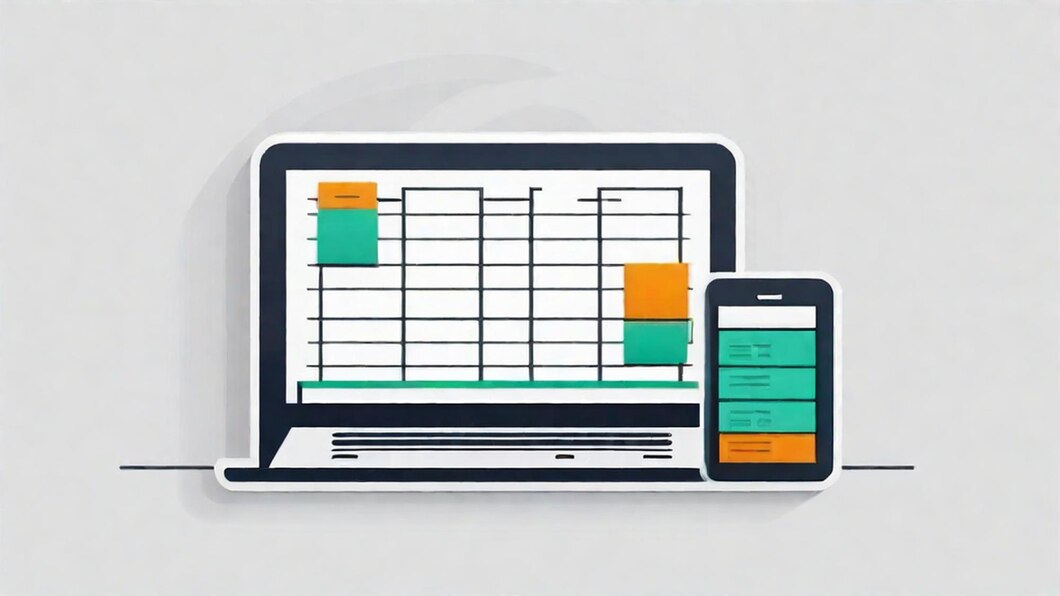Introduction to Spreadsheet Rectangles
When it comes to organizing data, few tools are as versatile and powerful as spreadsheets. Among the many features they offer, one concept stands out: spreadsheet rectangles. If you’re managing information—from budgets to project timelines—you might be wondering what these rectangles are all about. They can simplify your workflow and enhance your data visualization in ways you never thought possible.
Curious yet? Let’s dive into the world of spreadsheet rectangles and discover how they can transform your approach to handling data!
What are Spreadsheet Rectangles?
Spreadsheet rectangles are essentially defined areas within a spreadsheet that encapsulate data in a structured manner. They can range from simple cells to complex groups of cells, allowing users to manipulate and analyze information effectively.
These rectangles form the backbone of many functions and features in spreadsheet applications like Microsoft Excel or Google Sheets. They help organize data visually, making it easier for users to read and interpret.
When you select multiple contiguous cells, you’re creating a rectangle. This action allows for various operations like formatting, calculating sums, or applying formulas simultaneously across the selected area.
Understanding how to work with these rectangles enhances productivity while minimizing errors. As you delve deeper into spreadsheets, you’ll find that mastering this concept opens doors for more advanced techniques and functionalities.
How are Spreadsheet Rectangles Used?
Spreadsheet rectangles are versatile tools that help users organize and present data efficiently. They can be used to create structured tables, making complex information easy to digest.
Often, spreadsheet rectangles serve as the building blocks for charts and graphs. By selecting a specific range of cells, you can visualize trends in your data quickly.
These rectangles also play an essential role in formula application. Users can reference entire ranges or individual cells within these defined areas to perform calculations seamlessly.
In project management, spreadsheet rectangles assist with tracking tasks and deadlines. Color-coding different cells enhances clarity and prioritizes important information effectively.
Moreover, they enable collaborative work by allowing multiple users to edit or comment on specific sections without disrupting others’ contributions. This fosters teamwork while keeping everything organized at a glance.
Benefits of Using Spreadsheet Rectangles
Spreadsheet rectangles offer a range of advantages that can enhance your data management and analysis.
They allow for easy organization. By grouping related data within a rectangular area, users can quickly identify patterns or insights without the clutter of unrelated information.
Another key benefit is improved readability. Utilizing spreadsheet rectangles creates visual separation between different datasets. This clarity helps in presentations and reports where stakeholders need to absorb information quickly.
Efficiency also plays a significant role. With pre-defined areas for specific types of data, you minimize the time spent searching through cells or rows when updating figures or analyzing trends.
Furthermore, they promote collaboration among team members. When everyone understands how to navigate these designated sections, it streamlines communication and reduces errors during collaborative tasks.
Using spreadsheet rectangles encourages better planning too, allowing one to visualize project timelines or resource allocations effectively.
Tips for Creating Effective Spreadsheet Rectangles
To create effective spreadsheet rectangles, start by clearly defining your purpose. Know what information you want to convey and how it will be used.
Next, choose colors wisely. Use contrasting shades for the borders to make your data stand out. This enhances readability and navigability within the rectangle.
Keep it simple. Avoid cluttering with too much text or complex formulas in one area. Clear labels help viewers understand the contents quickly.
Utilize grid lines strategically to separate different sections of your rectangles without overwhelming the viewer’s eye.
Always test your layout on various devices or printouts to ensure consistency across formats. A well-crafted rectangle can significantly improve comprehension and efficiency when dealing with data.
Alternatives to Spreadsheet Rectangles
If spreadsheet rectangles don’t fit your needs, there are other methods to consider. One popular alternative is using tables in word processors. They allow for organized data display without the grid limitations of spreadsheets.
Another option is database management systems (DBMS). These tools handle larger datasets and offer advanced querying capabilities, which can be a game-changer for complex projects.
For visual learners, mind mapping software provides an engaging way to organize information hierarchically. This format encourages creativity while ensuring clarity.
Project management apps often come equipped with features that help visualize tasks and deadlines effectively. Options like Kanban boards or Gantt charts can provide a dynamic approach compared to static spreadsheet rectangles.
Each alternative has its strengths depending on the specific requirements of your project or team dynamics.
The Benefits of Using Spreadsheet Rectangles
Spreadsheet rectangles offer a variety of benefits that enhance data management and visualization. They create clear, organized sections within your document, making it easier to analyze information at a glance.
These rectangles streamline collaboration among team members. When everyone knows where specific data is located, communication becomes more efficient. No one has to waste time searching through cluttered spreadsheets.
Additionally, spreadsheet rectangles can improve the aesthetic appeal of your documents. A well-organized layout with distinct sections creates a professional look that impresses stakeholders and clients alike.
They also facilitate better data manipulation. By grouping related data together, users can quickly implement formulas or functions without getting lost in fragmented information.
Using spreadsheet rectangles promotes clarity and efficiency in routine tasks while enhancing productivity across various projects.
Common Uses of Spreadsheet Rectangles
Spreadsheet rectangles are incredibly versatile tools in data management. They serve various purposes across multiple industries, making them invaluable.
One common use is in financial modeling. Analysts create rectangles to represent budgets, forecasts, and cash flows clearly. This organization helps stakeholders visualize complex data at a glance.
Another frequent application lies in project management. Teams utilize spreadsheet rectangles for timelines and task assignments, ensuring everyone knows their responsibilities and deadlines.
In academic settings, educators often employ these structures to grade assignments or track student performance over time. By arranging data within defined areas, teachers can easily identify trends and gaps.
Marketing teams also benefit from spreadsheet rectangles when analyzing campaign performance metrics. They organize key performance indicators (KPIs) into clear sections for quick reference during strategy meetings.
Whether for analysis or presentation purposes, the flexibility of spreadsheet rectangles supports efficient decision-making processes across various fields.
How to Create and Use a Spreadsheet Rectangle
Creating a spreadsheet rectangle is straightforward. Start by launching your preferred spreadsheet application, like Microsoft Excel or Google Sheets.
Next, select the cells you want to include in your rectangle. Click and drag your cursor over them until all desired cells are highlighted.
Once you’ve made your selection, you can format these cells together. Use options like merging for titles or adjusting borders to emphasize key data points. This helps create a visually appealing layout that enhances readability.
To use the rectangle effectively, consider grouping related information within it. For instance, if you’re tracking sales data, place headers inside the rectangle with corresponding figures below.
Remember to utilize colors and shading strategically. They can help differentiate sections without overwhelming users with too much information at once.
Tips for Effectively Using Spreadsheet Rectangles
To effectively use spreadsheet rectangles, clarity is key. Begin by ensuring your data is organized logically. This makes it easier to identify what each rectangle represents, enhancing comprehension.
Utilize color coding to differentiate between various categories or status levels within your rectangles. Visual distinctions can streamline data interpretation and improve overall presentation.
Don’t shy away from merging cells when necessary. Merged cells can create larger rectangles that encapsulate related information succinctly.
Always keep the audience in mind. Tailor your layout for readability—avoid cluttering the spreadsheet with excessive text or complex formulas that may confuse users.
Periodically review and update your rectangles as needed. Keeping them relevant ensures they continue serving their purpose efficiently and effectively over time.
Alternatives to Spreadsheet Rectangles
When exploring alternatives to spreadsheet rectangles, various tools come to mind. Data visualization software like Tableau or Power BI can present information in a more dynamic format. These platforms allow users to create interactive charts and graphs that offer deeper insights.
Another alternative is using databases such as Microsoft Access or SQL-based systems. These options are excellent for handling larger datasets, enabling complex queries and data manipulation beyond what traditional spreadsheets can provide.
For collaborative efforts, consider project management tools like Trello or Asana. They help organize tasks visually while maintaining focus on team objectives without getting bogged down in numbers alone.
Mind mapping software also serves as a great substitute for organizing ideas creatively. It encourages brainstorming and offers flexibility in structuring information outside the confines of traditional grid layouts. Each option presents unique features that cater to different needs and preferences in data management.
Conclusion
Spreadsheet rectangles serve as a powerful tool for organizing and presenting data effectively. By understanding what they are, how they’re used, and the benefits they offer, users can unlock their full potential in various applications. Whether you’re managing budgets, tracking project timelines, or analyzing sales data, these rectangular blocks make information easier to digest.
Creating effective spreadsheet rectangles involves thoughtful design and an eye for detail. The right colors, borders, and formatting can enhance readability and comprehension. Remember that alternatives exist too; tools like charts or graphs might sometimes suit your needs better.
The common uses of spreadsheet rectangles highlight their versatility across different fields—from finance to education. Embracing this method could streamline workflows while improving clarity in communication among teams or stakeholders.
Exploring all aspects of spreadsheet rectangles not only equips you with knowledge but also empowers you to tackle any project with confidence. So whether you’re a seasoned pro or just starting out with spreadsheets, consider integrating these techniques into your routine for improved efficiency and clarity in your work!

















